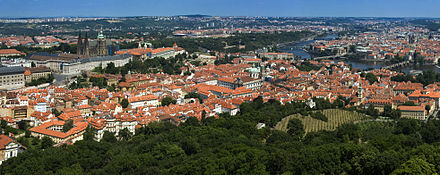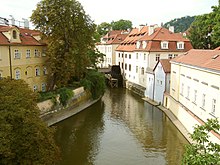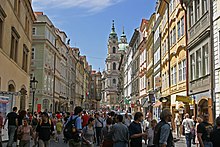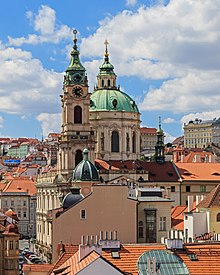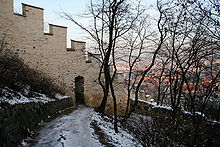Lesser Town of Prague
| Malá Strana | |||
|---|---|---|---|
|
|||
| Basic data | |||
| State : |
|
||
| Region : | Hlavní město Praha | ||
| Municipality : | Prague | ||
| Geographic location : | 50 ° 5 ' N , 14 ° 24' E | ||
| Residents : | 5,372 (December 31, 2014 ) | ||

The Lesser Town of Prague (Czech: Malá Strana ) with the Lesser Town Ring (Czech: Malostranské náměstí ) is a district of the Czech capital Prague . From 1257 to 1784 it formed a legally independent city below the Prague Castle with a character that was significantly different from the Prague Old Town . After two devastating fires, it became the city of the rich and the nobility, as can be seen from magnificent palaces and churches to this day. From 1784 the city wall became part of the unified Prague city fortifications .
history
Settlement in the early and high Middle Ages
Probably with the foundation of Prague Castle, a suburbium , a bailey , was formed underneath , which was fortified in the first half or in the middle of the 9th century by a wood-earth construction and a moat. A few years ago, the 23 m wide fragment of a building structure that had been used for a long time and probably related to long-distance trade was excavated in today's Brückengasse (Mostecká ul.) . Apparently, it is a question of the repeatedly repaired and fortified base of a public square or a street that was aligned with a wooden bridge north of today's Charles Bridge . Secondary fir wood comes from a more recent phase of frame or chamber construction, which, according to dendrochronological analysis, was felled in 828, 830 and 843 and presumably came from the first plant. The construction was repaired for the second time in 894, the fourth time in 927 and the fifth time in 942.
In the 960s, the Jewish-Arab merchant Ibrahim ibn Jaqub visited this center of international trade, which had now existed on the Lesser Town for over a century. Even before this time it had become an important station on the transcontinental traffic artery that led from the Volga region to Córdoba and primarily supplied the Islamic world with large numbers of slaves .
Establishment of the Lesser Town as a city
King Přemysl Ottokar II expelled the resident population, settled north German colonists in 1257 and, with the help of the royal locator Pitrolf, created the (first) new town (Nova civitas sub castro Pragensi) , which he provided with Magdeburg city rights . Already in the 14th century the city was called Civitas Minor Pragensis , the name Lesser Town (Malá Strana) has been preserved to this day. In 1283, the Gothic predecessor of today's St. Nicholas Church was built in the middle of the square, which resulted in the market being divided into two.
Expansion in the second half of the 14th century
During the reign of Charles IV , the city was expanded considerably from 1360 to 1362 with a new ring of walls, the Hunger Wall. A terrain was included from the Hradčany city via the initially free-standing Strahov monastery (Strahovský klášter) and the St. Laurentius church on the Petřín (Kostel svatého Vavřince na Petříně) to the Vltava . A large part of the Újezd settlement, one of the oldest localities in front of the old city gates of the Lesser Town, was thus included in the city complex of Charles IV. The new wall ring, which was connected to the Hradschin in the north, received two gates, one nearby the Strahov Monastery and the second in the aforementioned older settlement (Újezdská brána). However, the settlement process did not develop in the expected way in the Lesser Quarter, most of the newly gained urban area remained undeveloped and instead vineyards were planted on the slopes of the Petřín Mountains. These were built on the other slopes around the city by imperial order in 1358. The district east of the New Town still bears the name (Královské) Vinohrady (Royal Vineyards).
Most of the churches have also been redesigned within the new city walls of the Lesser Town. As early as 1350, the Romanesque church of St. John the Baptist on the Bleiche (Kostel sv. Jana Křtitele na Prádle), the parish church of the Újezd settlement, had a new nave. Around 1370 the new construction of the St. Maria under the chain (Kostel Panny Marie pod řetežem), founded in the 12th century, began, but only the mighty double tower facade and the western vestibule could be partially completed. In 1379 the church of the Augustinian Hermit Monastery of St. Thomas (Kostel sv. Tomáše) was completed. In addition, the palace of the Prague bishops (Bývalý biskupský dvůr) was rebuilt and expanded. Opposite it was the Saxon House (Saský dům), which Charles IV had given to the Saxon Duke Rudolf I in 1348 and which was then converted into a Gothic palace for the Prague residence of the Saxon dukes by 1408 .
Between the Hussite Wars and the Thirty Years War
In the Hussite Wars of 1419/1420, the city suffered so much destruction that it practically no longer existed. Further fire disasters hit the town in 1503 and 1541 together with the castle. With the rubble, the Kampa Island was raised and fortified. However, this meant that there was also space for aristocratic palaces in the Renaissance style in the entire Lesser Town. On July 26, 1648, Swedish troops under General Hans Christoph von Königsmarck took the city. The result is the Prague art theft . During and after the Thirty Years War , many of the existing palaces and almost all of the churches were redesigned or rebuilt in Baroque style.
In 1991 the Lesser Town of Prague had 8411 inhabitants. In 2001 the district consisted of 471 residential buildings in which 6809 people lived.
Attractions
Churches
- St. Nicholas
- St. Thomas
- St. Mary under the chain
- St. John the Baptist on the Bleach
- St. Laurence
- Mary of Victory
- Church of the Virgin Mary of Perpetual Help: The Lesser Town Gate or Strahover Gate stood on the same level as the Maria Church of the Kajetans and was demolished in 1711. The Church of the Virgin Mary of Perpetual Aid to the Kajetans (Kostel Panny Marie u Kajetánů) was built here by 1717 with the layout of a Greek cross.
Palace
Gardens
Prague bishop's court
The remains of the palace of the Prague bishops (Biskupský dvůr) have been preserved in the courtyard of the house on Brückengasse 16 (Mostecká CN 47) “To the three bells” (U tři zvonů) . The gate tower of the Gothic episcopal palace still stands here today. Already at the end of the 12th century the bishop had his seat between Brückengasse (Mostecká) , Josefsgasse (Josefská) and today's Dražický Square (Dražického náměstí) ; previously it was in Prague Castle on the site of the old provost house. Between 1182 and 1196 the bishopric was moved here. At that time the Palatinate consisted mainly of wooden buildings, but remains of Romanesque stone buildings have also been preserved in the cellars . Around 1263 the area was reinforced in connection with the establishment of the Lesser Town. Even before 1344, and thus also before Prague was elevated to the status of an archbishopric , it underwent a strong Gothic redesign and was decorated with magnificent paintings and sculptures.
The originally Gothic tower in the courtyard bears the coat of arms of the two builders, Bishop John IV of Dražice (with a vine branch) and Archbishop Johann Očko von Wlašim . In the Hussite Wars of 1419/1420 the Palatinate was destroyed and then not rebuilt. After the restoration of the archbishop of this resided since 1562 at the Archbishop's Palace on Hradcany Square (Hradčany) .
Saxon house
Opposite the Bishop's Palace is the Saxon House (Saský dům, Mostecká No. 3 / CN 55). This, too, previously formed a large, independent block as part of the Lesser Town fortifications and, under the name Welsches Haus, served as a trading center and residential town for long-distance traders in the manner of the Teynhof . It was an extra-territorial area to which both Lesser Town bridge towers belonged as a property, which only later came to the old town through exchange.
In 1348 Charles IV donated the building to the Duke of Saxony-Wittenberg, Rudolf I , who had it converted into a Gothic palace. From 1408 to 1909 the Saxon dukes used it as their Prague residence. On the first floor, ogival windows were discovered during a restoration in the 1960s. The surrounding walls are still Gothic and the cellars also still show the original vaults. Today's appearance largely stems from a renaissance reconstruction a few years before 1600, which also includes the renaissance portal. The coat of arms of the Lesser Town was added much later, around 1780.
Hunger Wall (Hladová zeď)
At a great distance from the old city wall of the Lesser Town, a new six meter high and two meter wide city fortification was built between 1360 and 1362, large parts of which have been preserved to this day. It is said to have got its name due to a famine at the end of the construction period. The construction work may also be due to the large number of workers who became redundant after the work on the residential buildings in New Town and in Karlštejn Castle was completed and who found new employment here. Franz Kafka wrote his story “ When building the Great Wall of China ” based on the hunger wall. In this narrative, the Great Wall of China is also something "inexpedient," an occupational therapy for the unemployed, so to speak.
Petřín lookout tower
The Petřín Lookout Tower ( Petřínská rozhledna in Czech ) is a 60-meter-high observation and transmission tower on the Petřín Mountain , modeled on the Eiffel Tower , which was built in 1891. Today the observation tower is a popular tourist attraction.
Wendish seminar
The Wendish seminar, founded in 1724 (also Lusatian seminar , Lužický seminář in Czech) was until 1922 a training center for the mostly Sorbian Catholic priests of Upper Lusatia and today serves as the seat of the Society of Friends of Lusatia, whose library is housed here, as well as the state representative of the Free State of Saxony .
literature
- Jaroslav Schaller: Description of the royal. The capital and residence city of Prague, along with all the interesting sights found in it: The Lesser Town, or the III. Main district of the city of Prague . Prague: Geržabeck, 1795
To the early and high Middle Ages
- J. Čiháková, J. Dobrý: Dendrochronological processing of wood from the archaeological research of the Prague suburbian. In: Poláček, L. / Dvorská, J. (Ed.): Problems of Central European Dendrochronology and scientific contributions to the March valley floodplain. International Meetings Mikulčice 5. Brno 1999. pp. 39–54.
- J. Čiháková, Z. Dragoun: Nástin vývoje podhradí Pražského hradu do poloviny 13. století. (Outline of the development of the suburbium of Prague Castle up to the middle of the 13th century.) Archeologické Rozhledy 49, 1997, pp. 56–64.
- J. Čihákova, J. Zavřel: Ibrahim Ibn Jakub's itinerary and the new archaeological discoveries on the Lesser Town. In: Charvát, P. / Prosecký, J. (Ed.): Ibrahim ibn Ya'qub at-Turtushi. Christianaty, Islam and Judaism meet in East-Central Europe c. 800-1300 AD Praha 1996. pp. 65-71.
From the late Middle Ages to the present and the monuments
- Knaur's cultural guide Czech Republic. Munich 1993, ISBN 3-426-26609-1
- Umělecké památky Prahy 3. Malá Strana. Praha 1999, ISBN 8020007717 .
Web links
Footnotes
- ^ Prague city walls. (No longer available online.) In: burgenwelt.org. Archived from the original on December 8, 2015 ; accessed on November 29, 2015 . Info: The archive link was inserted automatically and has not yet been checked. Please check the original and archive link according to the instructions and then remove this notice.


